2010 Civil War Travelogue
Welcome to my 2010 Travelogue page, Part 5. Go to 2010 Travelogue Part 1, Part 2, Part 3, Part 4.
| Here is a reminder about the reason I write these pages the way I do. They record my experiences and impressions of Civil War trips primarily for my future use. Thus, they sometimes make assumptions about things I already know and focus on insights that I receive. They are not general-purpose descriptions for people unfamiliar with the Civil War, although I do link to various Wikipedia articles throughout. Apologies about the quality of interior photographs—I don't take fancy cameras with big flashes to these events. If you would like to be notified of new travelogues, connect to me via Facebook. |
Civil War Preservation Trust Interview, November 12
I was honored to be interviewed for the website of the Civil War Preservation Trust, focusing on my role as a Color Bearer and Wikipedia contributor. Read the interview here.
West Coast Civil War Roundtable Conference in San Francisco, November 12–14
I attended my fourth West Coast Civil War Roundtable conference, this year in San Francisco, sponsored by the San Francisco Civil War Roundtable and the Friends of Civil War Alcatraz. The theme was "Blood on the Ramparts," Coastal Defenses in the American Civil War. I really enjoy these West Coast conferences because they have excellent speakers, are well organized with a lot of good content, and are very inexpensive. You can read about my previous experiences: Sacramento in 2006, Clovis (Fresno) in 2008, and Clovis in 2009. The venue was the San Francisco War Memorial, which consists of two nearly identical buildings on Van Ness Avenue across from City Hall: the famous Opera House and the building that houses Herbst Theater. We met in the latter. (My friend Gary Yee of the SF CWRT, who was a conference co-chair, happens to be in charge of security for the complex.)
(Note to readers: I usually include a number of links to Wikipedia articles of interest, and these are very frequently ones that I wrote myself. In the case of this conference, there are many naval references that I had nothing to do with.)
Friday, November 12
We started late in the afternoon with registration and a visit to a room with book sales and a number of items to be raffled off during the weekend. This was followed by a nicely catered dinner and talks hosted in the dining room. After introductory remarks by Jim Harper of the Sacramento CWRT, we were introduced to a 19-year-old student who read a poem she had written, "Bloody Nights to Starry Skies." I am sorry to say that I have no natural knack for understanding poetry, so can say only that I appreciated her effort at memorializing an event most of her contemporaries ignore.
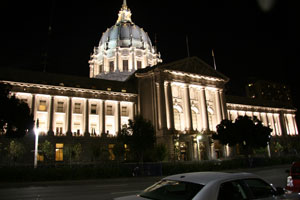 |
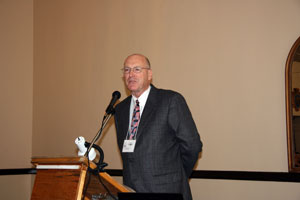 |
| SF City Hall next door | Jim Harper |
Our first historian speaker was one of my all-time favorites, Craig L. Symonds, a former longtime professor at the Naval Academy and the author, most recently, of Lincoln and His Admirals. His presentation, "The U.S. Navy on the Eve of War," talked about the challenges of building up the Navy required for the war, but his thesis was that the U.S. Navy was better prepared for this war than any other until 1941. At the start of hostilities, there were fewer than 90 ships and only 42 of these were capable of combat, although many of those were stationed overseas. He took us through a history of steam-powered warship technology in the 1850s. The United States emphasized sailing ships in the antebellum Navy because we did not have an elaborate series of overseas coaling stations available, so by the mid-1850s there were only 24 screw (propeller driven) frigates in operation. He discussed three classes of steam warships: the Merrimack class, of which six were built; the Hartford class (the Hartford was Farragut's flagship during the war), five; the Mohican class, six, the first ships that were designated to be primarily steam powered, rather than "auxiliary" (sailing ships that were augmented by steam). He discussed the ordnance available and made the interesting statement that a sailor from Sir Francis Drake's navy would recognize the technology up until about 1850, when the introduction of explosive shells and rifled barrels changed naval gunnery substantially. It was during this period that guns began to be referred to in terms of inches (projectile diameter) rather than pounds. He talked about guns designed by Dahlgren, Rodman, and Parrott. I was intrigued to hear about a 20-inch Rodman, which is larger than any naval cannon used since. Only three were built, but none were deployed in combat.
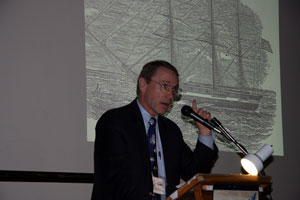 |
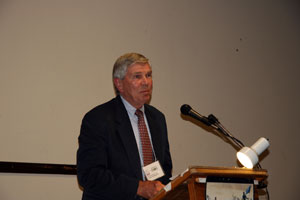 |
| Craig L. Symonds | James M. McPherson |
James M. McPherson spoke on "Confederate Coastal Defense." He discussed the challenges to the Union of blockading a coastline that was 3,500 miles long, with 189 ports, but suggested this was also a daunting challenge for the Confederates to defend. As he began to discuss the successes and failures of both sides, he included both the coastline as well as some of the important rivers during the war. He maintained that there were four components to the defensive efforts: the small Confederate Navy, defensive fortifications, obstructions (torpedoes/mines, cables, nets, etc.), and commerce raiders.
Saturday
Rick Hatcher, who is the NPS historian for Forts Sumter and Moultrie, gave a lengthy two-part talk about coastal defenses and combined operations in Charleston. He started his history in 1670 with the formation of the city, and told us that it was the busiest port before the Revolutionary War. The Battle of Sullivan's Island in 1776 was an unsuccessful attempt by the British to capture the city, and which demonstrated how impervious a log and sand fort could be to naval cannonballs of the time. The British withdrew and returned in 1780 to lay siege to the city, which was successful and the city fell on May 12. Rick described the construction of Fort Moultrie in 1809. A variety of people famous in the war were stationed there at one time or another, including Braxton Bragg, William T. Sherman, George H. Thomas, and John F. Reynolds. Fort Moultrie had two significant problems as the war became more likely—drifting sand dunes had climbed up the face of the fort, resulting in instances of cows grazing on the parapet, and a number of tall civilian houses had been erected nearby, interfering with fields of fire. Fort Sumter was named after Thomas Sumter, the last survivor of the Revolution. Rick proceeded to describe the actions at Sumter, Port Royal, Fort Pulaski, and the siege of Charleston. In a brief description of the Battle of Secessionville, he mentioned that it was the largest battle fought in South Carolina. He talked about all of the confusion of the rivalry between Brig. Gen. Quincy A. Gillmore and Adm. John A. Dahlgren during the abortive September 8, 1863, infantry assault on Fort Sumter. One of the reasons the Confederates had an advantage is that they had been able to recover the codebook from the USS Keokuk (sunk in the naval assaults against Fort Sumter). He said that during the bombardment of Fort Sumter in 1863, the Union fired 46,000 rounds.
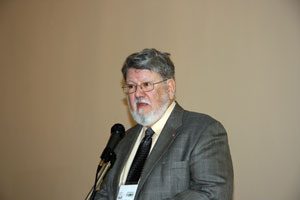 |
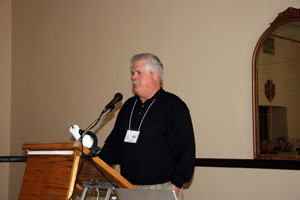 |
| Rick Hatcher | John Martini |
John Martini, an NPS ranger at Alcatraz, spoke on the "Harbor Defense of the San Francisco Bay Area." John entertained us with a number of very interesting historical photographs of fortifications in the day. There were three primary forts planned. Fort Point was the first, an example of the "Third System" of fortifications, those masonry edifices that were designed after the war of 1812. These typically had one to three floors of casemated guns (brick-protected rooms with a tiny gun port) and one on the top of barbetted guns, which were in the open, but were therefore more flexible in terms of aiming on a wide arc. The second fort, Lime Point, in Marin County on the northern end of the Golden Gate, was not built because speculators had bought up the land and made it too expensive for the government until after the war (when it became Fort Baker). The third was Alcatraz Island. These three forts were to provide a triangular defense against any ship entering the Bay. At various times there were 86 to 126 guns on Alcatraz and a total of 216 around the Bay. Alcatraz had 500 men assigned and they were equipped with provisions to survive a five-month siege. One of the original engineers, James B. McPherson, had designed a "citadel" building for the close-in combat defense of the Fort. At the start of the war, Albert Sidney Johnston was in command in San Francisco and he ordered immediate completion of Fort Point, ensuring that some of the cannons were mounted facing south in case local secessionists attacked it. In 1863, additional batteries were placed at Point San Jose (now part of Fort Mason), and three on Angel Island. Also in 1863, the Union ironclad Camanche, built in Jersey City, was disassembled and transported by ship to San Francisco, but the transport ship sank. The ironclad was salvaged and restored at Mare Island, ready for duty in May 1865.
After lunch, Jim Stanbery spoke on "Union Amphibious Operations during the War." Readers of my previous reviews have encountered my opinions on Jim's unconventional style of doing PowerPoint presentations and he was in the same form this year. It is possible that this year, however, set a new standard for the number of words that could be squeezed on a single PowerPoint slide and then read verbatim to the audience. Jim based his presentation on Rowena Reed's controversial 1978 book, Combined Operations in the Civil War, and he regaled us with lengthy passages of opinion copied from her book. I found Reed's book to be very interesting, although I think she was rather optimistic in assuming that coastal incursions could have been used to great strategic effect by seizing inland railroads.
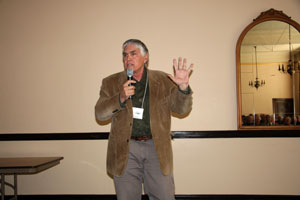 |
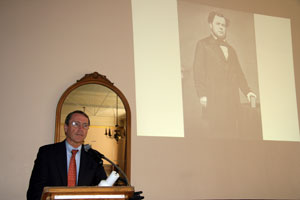 |
| Jim Stanbery | Craig Symonds and Stephen Mallory |
Craig Symonds returned for a presentation entitled "Confederate Navy and the War in the Pacific," although he did not talk much about the Pacific. He described Stephen Mallory's strategy for dealing with a superior Union Navy as threefold: (1) innovation in technology and tactics; (2) attack Union commerce; (3) coastal fortifications. The Confederacy planned to build 50 ironclads during the war, but were able to complete only 22. Confederate issuance of letters of marque began on April 17, 1861, only three days after Fort Sumter surrendered. Craig assumed that the Union announcement of the blockade on April 19 was affected by this decision. He said that privateers lost interest early in the war because neutral ports could not accept the prizes that would be used to compensate the captains. He talked about the lengthy and consequential voyage of the CSS Shenandoah, which was particularly relevant to this conference because its captain, James Waddell, planned an attack on San Francisco, but when he was informed that the war had ended, he reversed course and returned to England. Craig said that when he surrendered on November 5, that was the last Confederate combatant to do so, so that is arguably when the war actually ended. In the question-and-answer session, Craig addressed the efficiency of the Union blockade. Although many Confederate ships did get through, there was a 90% reduction in the freight processed by Southern ports, so he judged it to be an overall success.
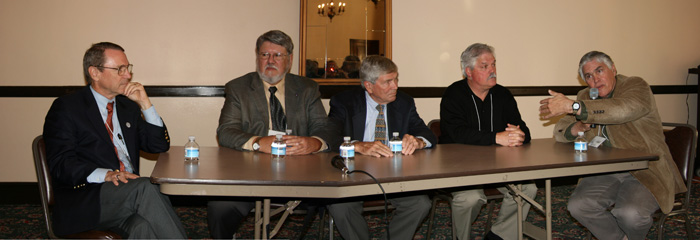 |
| Panel: Craig, Rick, James, John, Jim (the odd table shape above is an artifact of photo-merging two shots) |
A panel discussion followed and there were a few highlights. In a discussion of the best and worst admirals of the war, Craig pointed out that there were no political admirals, so there were no grossly incompetent men (unlike some of their Army counterparts), but if forced to choose, he thought that Lewis Goldsborough and Franklin Buchanan were not as effective. James McPherson thought that the two best were David Farragut and David Dixon Porter, although the latter was sometimes difficult to deal with. Craig added that Raphael Semmes was also a good choice, and that he had the unique distinction of being both an admiral and a brigadier general during the war. The panel thought that ironclads were not as effective as most people assume. They were very slow in firing and were difficult to maneuver, primarily because their engines were underpowered for their great weight. A discussion about the H.L. Hunley yielded the tidbit that brain tissue from the crew was recovered and demonstrated that they did not drown, they were us asphyxiated, but no one knows exactly why it happened. My award for the most unusual question of the day went to the person who asked whether you could reuse cannonballs that were shot at you. (The answer is no, other than by melting them down.)
Next we had a tour of the War Memorial. The buildings are quite historic. They were completed in 1932 and were the site for the signing of the United Nations charter (in what is now called Herbst Theater) and the Treaty of San Francisco (in the Opera House), which was the peace treaty that ended the war with Japan in 1951. There is a small exhibition of military medals and small arms. I would have taken more photographs, but our tour guide insisted they were not allowed for some reason.
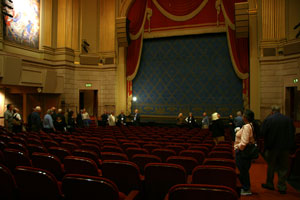 |
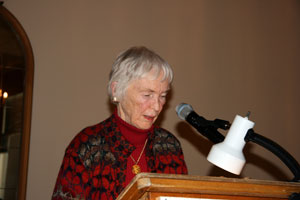 |
| Forbidden photo of Herbst Theater | Helen Trimpi |
We split into three groups and chose to listen to one of three authors of Civil War books. I went to see my friend Helen Trimpi, who described how she, as an English major, became interested in the war, and the process she used to write her book Crimson Confederates, a compilation of brief biographies of all of the Harvard graduates who fought for the South. She included 357 biographies, but was frustrated to realize after going to print that she missed one—Brig. Gen. Albert Pike. The two highest ranking officers were Rooney Lee and John S. Marmaduke. A large percentage of the Confederates were graduates of the law school, attracted to a northern university because there were very few law schools at the time, and Harvard's was particularly prestigious. I was amazed to hear how difficult the editing process was and how much information she had to leave on the "cutting room floor," so to speak.
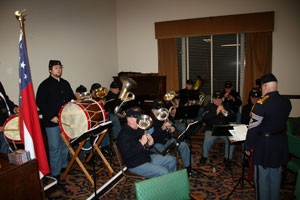 |
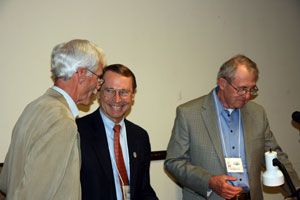 |
| Fifth California Band | Craig Symonds receiving Jerry Russell award (Fred Bohmfalk, conference co-chair, on right) |
Before dinner we were serenaded by the Fifth California Volunteers Infantry Band. After dinner, Craig received the Jerry Russell award—in recognition for battlefield preservation efforts—from the CWRTs and James McPherson returned to talk about "Those Infernal Machines (Confederate Mines)." Unfortunately, he did not have an awful lot to say about them. Some mines were experimented with in the Revolutionary War and the War of 1812. Torpedoes damaged 43 Union ships, sinking 29. He then turned to "subterranean torpedoes" (landmines), discussing their use at Yorktown and Williamsburg in the Peninsula Campaign, as well as the Richmond–Petersburg Campaign. By November 1864, there were 1,300 deployed around Richmond, but oddly, none around Petersburg that he can find. He then proceeded to discuss the differences between "total war" (a term he has himself used in previous works) and "hard war" (a more recent term that was derived from a book written by Mark Grimsley). By this time it was after 8:30 PM and I was getting a bit fatigued, so I did not stick around for the raffle that followed McPherson's talk.
Sunday
The conference concluded with a day of travel around San Francisco. We met at Pier 33 and took an early boat to Alcatraz Island. It is hard to believe, but I have lived in this area for over 30 years and this was my first visit to the island. Unlike many days in San Francisco harbor, where it is often cold and windy, the weather was warm and stunningly beautiful. We split into three groups and had detailed tours for two and half hours, examining the history of Alcatraz with a strong focus on the Civil War fort. There is not much left of the many gun emplacements, but we were led through moats and basement areas where we could see some of the original masonry. We also walked around some of the areas on the western side that are not normally open to the public, which paid off by displaying fabulous views of the Golden Gate Bridge. We spent some time in the factory room that was used for the big fight scene in the Nicholas Cage movie, The Rock. (Although they filmed at Alcatraz for over six weeks, many of the interior shots were done in a Hollywood studio.) At one point we were required to wear hard hats as we navigated areas with very low headroom. The lower level of the original citadel still stands underneath the 20th century prison building. I was surprised to learn that the island was originally rather rounded in shape, but the postbellum Army used convict labor to carve away over 70 feet of rock to create the current parade ground. At one time they contemplated leveling the entire island in that way. We concluded by going through the federal prison, along with hundreds of other tourists, and saw the cramped cell conditions, including the cell that Al Capone resided in for part of his incarceration, and got a demonstration of how the automatic door system worked, which results in a very dramatic metallic slamming noise. Our guide, John Cantwell, said that George Lucas has recorded that sound and used it in all of his motion pictures. One of the odder parts of this visit was encountering a former convict of the prison, who was introduced to a big round of applause. He was a bankrobber who had attempted escape from another federal prison, so was sent Alcatraz, where he served four years. I did not think this was a particularly applause-worthy accomplishment.
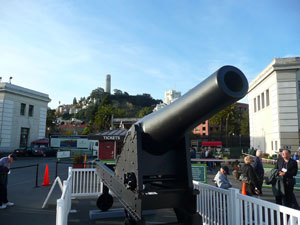 |
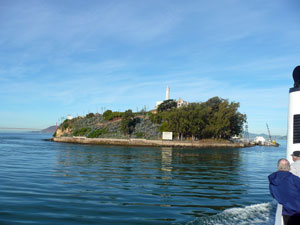 |
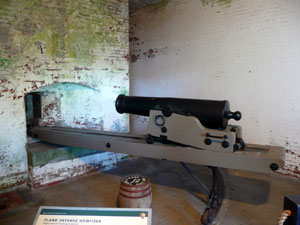 |
| Plastic 15-inch Rodman gun at Pier 33 | Alcatraz from the boat | Howitzer in casemate |
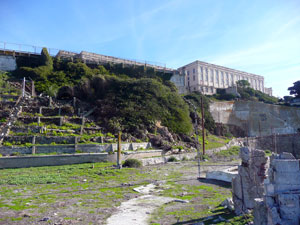 |
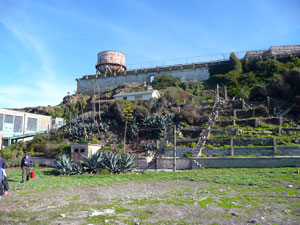 |
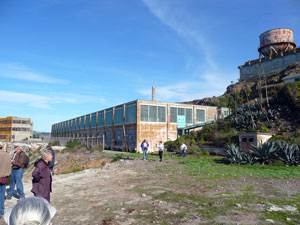 |
| West side of island | West side | Factory |
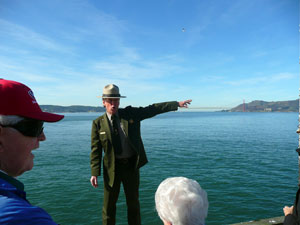 |
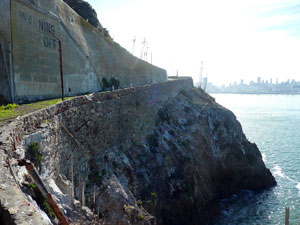 |
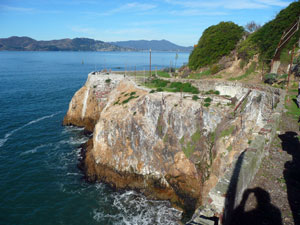 |
| Ranger John Cantwell | West side, restricted area | Ditto |
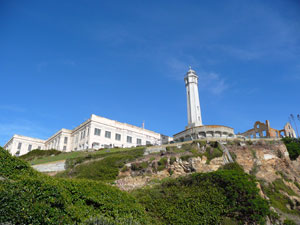 |
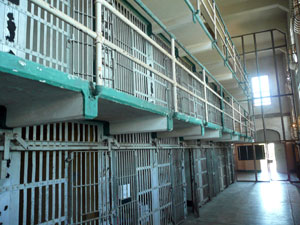 |
| Lighthouse (ruins of commander's/ warden's house on right) |
Cell block in federal prison |
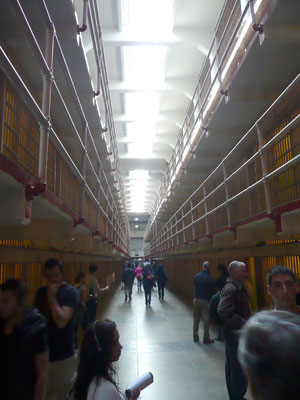 |
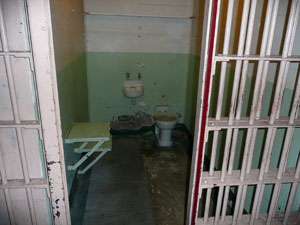 |
| Tourists at the prison | A typical cell |
After returning by boat, a beautiful 15 minute ride, we boarded two buses. In our bus, the first stop was the Presidio of San Francisco. We did not get off the bus (which is the reason I have no photographs), but cruised around with an NPS Ranger and saw some of the few Civil War buildings on the post. Gary Yee was very enthusiastic about finding the house where Emory Upton committed suicide; the ranger thought that Upton lived in the BOQ. Probably the most interesting story here was that Herb Alpert was an Army bugler at the Presidio, and Jerry Garcia also served here as an Army musician.
 |
| Panoramic view of San Francisco from Alcatraz |
The next stop was Fort Point, which I had visited a few times previously, directly underneath the Golden Gate Bridge. As mentioned earlier, it was the first of the fortifications built, and one of its designers was Custis Lee, Robert E. Lee's son. By the time of the war it was essentially obsolete. It never fired a shot in anger, although we heard about an incident in 1864 in which the commander of the British Pacific Fleet sailed into the Bay without notice. The soldiers could not see the British flag and, concerned that it might be a Confederate raider, they fired a warning shot across its bow, which resulted in an embarrassing international incident. We were escorted by a father and son team of men dressed in 19th century artillery uniforms, who escorted us all over the fort, including the powder magazine (where, amusingly, it was not against regulations to smoke on duty), some casemated guns, the barbette positions on the roof, the lighthouse, and the quarters for the officers and enlisted men.
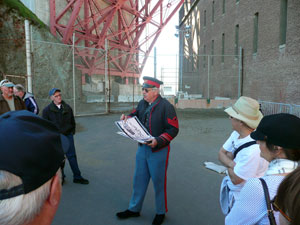 |
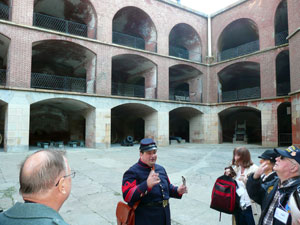 |
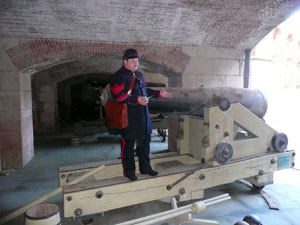 |
| One of our guides outside Fort Point | His son, inside | Gun in casemate |
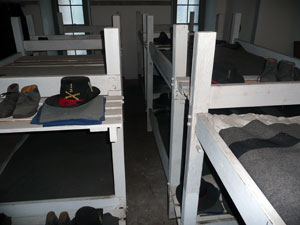 |
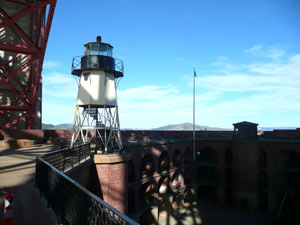 |
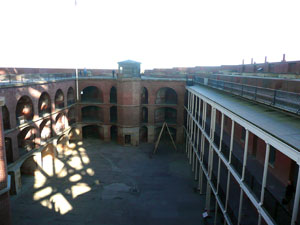 |
| Enlisted men's barracks (six soldiers to a bunk) | Postbellum lighthouse | View from the barbette level |
Finally, we visited Fort Mason. We did not visit the lower fort, where all the warehouses and piers were used for World War II embarkations, but the portion at the end of Franklin Street. Bob Bowen, of the South Bay Civil War Roundtable, escorted us past a few houses that were built by squatters before the war. These men were actually distinguished members of the community, but they built on government land without permission. One was a newspaper editor, Leonidas Haskell, whose claim to fame was that he was a friend of Sen. David Broderick, who was killed in the Broderick-Terry duel in 1859. Another was John C. Frémont, Civil War general and the first Republican presidential candidate. Both of these were eventually kicked out of their houses by the Army. We also saw the former officers club, which had been the residence of the commander of the Presidio, called McDowell Hall after Irvin McDowell. In 1906, this building was the Army headquarters that dealt with the emergency of the earthquake and fire.
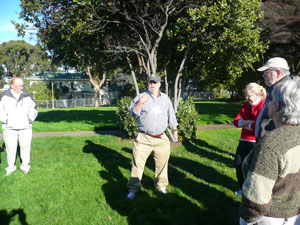 |
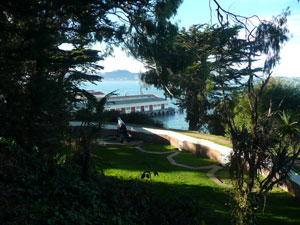 |
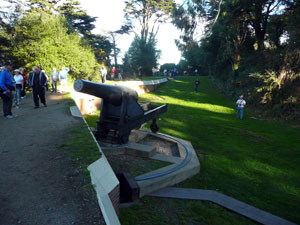 |
| Bob Bowen at Fort Mason (McDowell Hall in background) |
Battery at Point San Jose (Fort Mason) | The single cannon remaining there |
All in all, it was a great weekend with about 100 Civil War enthusiasts on the West Coast. The next conference will be in Sacramento, November 11-13, 2011. The subject will be the first year of the war, capitalizing on the 150th anniversary of 1861. I hope to attend that, schedule permitting.
U.S. Army Staff Ride, Charleston, November 18–22
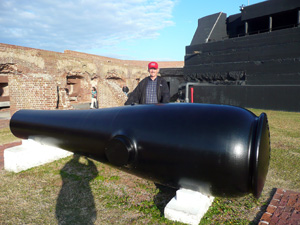 |
| Hal at Fort Sumter. This is not a trick photo—this Rodman Columbiad tube is HUGE! |
For my final Civil War trip of 2010, I had a unique experience. Last year at the West Coast Civil War Roundtable Conference I met Glenn Robertson of the Combat Studies Institute at Fort Leavenworth, who is the prime mover behind the renaissance of the staff ride concept in military education. He offered me the opportunity to ride along on a future staff ride with students from the Army's Command and General Staff College and I eagerly accepted. The only conditions were that I create no expense for the government and that I respect the fact that students were learning from the exercises and interchanges with the instructors and I should not attempt to monopolize such with my own questions and opinions. He hooked me up with Dr. Curtis King, who had space available for a Charleston staff ride.
Over the last few years, I have taken a few staff rides with Parker Hills and the Blue and Gray Education Society and I was interested to compare and contrast those staff rides with the original Army version. I was also intrigued to find out what sort of lessons modern Army officers would learn from the wartime experiences in Charleston. I had visited Charleston once before (see my 2005 report), but I was able to explore a number of new places this weekend.
Note: As with the West Coast conference report that precedes this one, there are a few Wikipedia links here about Charleston battles. I did not write any of them and have not edited them yet, so they are not up to my usual standards of battle articles.
Thursday, November 18
I had a good flight through Chicago to Charleston, which is a very dinky airport, but therefore quite convenient. I checked into the Courtyard by Marriott Charleston Waterfront, a very nice hotel on the Ashley River, next to a marina. (One caveat for readers: neither of the two Marriott properties are within walking distance of "downtown" Charleston, but driving around Charleston is pretty easy.) The officers on the staff ride stayed down the street at the considerably more expensive big Marriott, so perhaps they are taking advantage of a government rate. Or maybe it's Obama stimulating the economy.
Friday
I really had no specific information about this staff ride before I arrived, so I was moderately surprised to find that only three officers were in attendance. (The fourth had a conflict and did not show up until Saturday.) I had envisioned a big busload of majors and senior captains, but this happened to be from a small class at Fort Leavenworth, so the three officers, two civilian instructors (Curt and Gary Linhart, both former West Point graduates), and I fit into a small van today. Curt explained that they often have as many as 16, in which case they assign each of the students to play a role representing one of the major participants, getting them to become familiar with the man's biography and then representing him in terms of decision-making discussions during the ride. In the case of this smaller group, each of the students had reading assignments to research and present a broader pool of information, such as all of the Confederate operations in 1862.
As I had expected, all of the officers were smart, well spoken, friendly, and professional (although they looked a lot younger than the field grade officers did when I was in the Army!). They dressed in casual civilian clothes and everyone went on a first name basis, so I don't know their exact ranks. One was an infantry officer and two were in logistics. (This latter classification puzzled me. I had not been aware that the quartermaster, ordnance, and transportation branches had been merged into a common logistics branch, although they explained that this does not affect the first few assignments of a junior officer, who starts concentrating in one of the three disciplines. Perhaps I should have retained my Army Times subscription.) The fourth, who arrived on Saturday, turned out to be a lieutenant commander in the Navy—quite an appropriate mix of students for a campaign heavy on both Army and Navy elements.
Our first stop was Fort Moultrie on Sullivan Island. We discussed briefly the history of the fort and its role in the Revolutionary War. The fort also was in use until after World War II, so there are artifacts from many military eras, such as sections of sturdy black concrete bunkers ("Endicott" style fortifications) and elaborate "disappearing rifles." There was a very interesting display of the immense Civil War era heavy guns, and I was particularly impressed by the humongous 8- and 10-inch Parrott rifles. We got a thorough orientation to all of the landmarks and facilities in the harbor, enhanced by excellent maps that the CSI produced (using PowerPoint, to my surprise) and had blown up in large format. Fort Moultrie was the installation that Major Robert Anderson and his small garrison were manning in late 1860, but then he relocated them all to the unfinished Fort Sumter in the middle of the harbor. We had a good discussion of the various options, both military and political, that Anderson was faced with. I told a joke about how a JAG officer might have helped Anderson and Curt said that Gen. Petraeus had several JAG officers on his staff for legal advice. We visited the small visitor center very briefly and did not have an opportunity to see the 22-minute film because we were on a tight schedule.
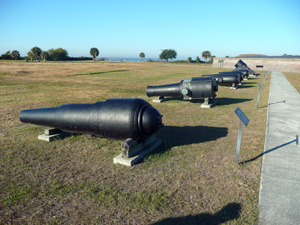 |
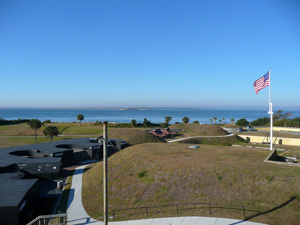 |
| Cannon display at Fort Moultrie | Some of the different technology eras are side-by-side at Fort Moultrie |
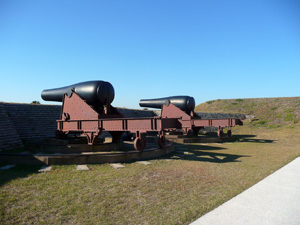 |
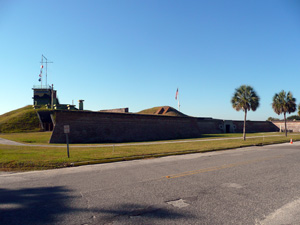 |
| Big Rodman pieces | Outer view of Fort Moultrie |
We drove to James island and stopped at Fort Johnson. It was from here that the first shot was fired on Fort Sumter. There is not much more than a beach, a small powder magazine, and a marker now, although there is a stunning view of the harbor. The land is owned by the Marine Resources Division of the College of Charleston. We discussed in detail how the Confederate and Union artillery were placed around the harbor and then briefly described the bombardment and Union surrender. It was interesting to contrast the courteous relationship between the parties in 1861 with the decisions a U.S. commander would have to make today, knowing that surrender to the Taliban is not an option.
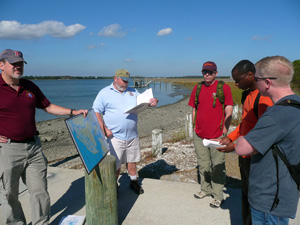 |
| Battery Island |
The western end of James Island is bordered by the Stono River. The British Army used this as their avenue of approach when they captured Charleston in 1780, so it was obviously worrisome to the Confederates, and it was the nexus of various actions in 1862 that we discussed for most of the rest of the day. The first stop was Battery Island, which is on the Stono just to the west of Sol Legare Island (pronounced Sol Legree by the locals, and allegedly the Legare family is the source for the name Simon Legree in Uncle Tom's Cabin). Here we went over John C. Pemberton's biography and talked about the pluses and minuses of defensive positions that he could select on James Island. We also discussed Robert Smalls, the slave who commandeered the vessel Planter and delivered valuable intelligence information to Adm. Du Pont; this led to a discussion about how to evaluate civilian sources of information in our modern conflicts. I was impressed that the students were very well-prepared and this version of the staff ride requires a good deal of exposition by the students. The instructors asked them to present quite a bit of information, rather than simply answering pointed questions.
We took a break for lunch at a barbecue restaurant called Melvin's on James Island and I was very impressed with the quality of the food. The odd thing on the menu was that many selections included a single onion ring, but it was larger than most doughnuts—a single thin ring of onion expanded with at least an inch of dough all around. Delicious, I must say.
Our next stop was Grimball's Farm, where Union troops entrenched prior to the Battle of Secessionville. There is not much to see here, a cemetery and construction going on for some housing. Then we drove to Fort Lamar, which was the focus of action in the Union attack at Secessionville, June 16, 1862. This was a moderately well preserved set of earthworks tightly fitted in between two streams and marshes, which channeled the Union attack into a very narrow frontal assault. The students went into considerable tactical detail discussing actions in this battle, which resulted in a Union repulse and the arrest of the commanding officer, Brig. Gen. Henry Benham.
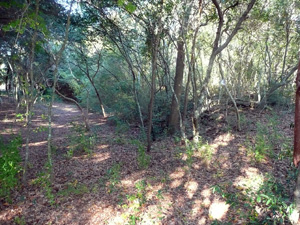 |
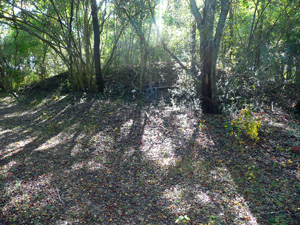 |
| Earthworks at Fort Lamar (these always look more interesting in person than in photographs) | More |
Also after that battle, Pemberton was replaced by Charleston favorite P.G.T. Beauregard, who proceeded to reorganize the defensive lines on James Island. We discussed this at Battery 5, one of the fortifications along the line that blocked the most likely approach from the Stono. We explored various options the Union could have theoretically used to attack Charleston and determined that the approach across James Island was the most dangerous to the Confederates and also the most likely, so we gave Beauregard good marks for his efforts. Our final stop for the day was the Dill Plantation, which is a large property on the Stono that is now owned by the Charleston Museum and is preserved primarily for ornithological and archaeological research. It is closed to the public, but the positive reputation of the U.S. Army and $15 a head gained us entry. On the grounds is the site of Battery Pringle, the western end of the Beauregard line, which is a large fort in superb condition. It is very easy to see (although, lamentably, difficult to photograph) the tall walls, the bombproof, the magazine, the gun positions, and the traverses. All of these earthworks are covered with trees, but the curator explained to us that the root balls are actually holding the earthworks together, preventing their erosion. He also got out his iPad and showed us something really fascinating—a LIDAR aerial shot that clearly showed all of the entrenchments in the area, despite most of it being covered by vegetation, including a well defined fort on the other side of the river, which has been cut in half by an airport runway. I wish someone would do this for more battlefields.
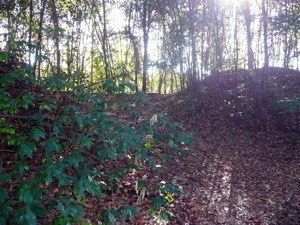 |
 |
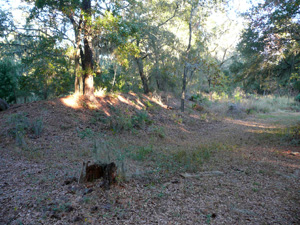 |
| Remnants of Battery Pringle | More | More |
Saturday
Today our fourth officer showed up and there was no room in the van for me, so I followed behind in my rental car. We started at Battery Ramsey, located at the southernmost tip of downtown Charleston. There is nothing left of the battery other than a park with some artillery pieces and memorial statues. Here we discussed the Union naval attack on April 7, 1863. We pored over a map of the location of harbor defenses, including booms, ropes, and mines, and discussed the background of Adm. Du Pont. We also discussed the brief breakout of the Confederate ironclads Chicora and Palmetto State, which could have potentially led to the declaration that the blockade had been broken, but the British did not bite. We also discussed Du Pont doing a test run with his monitors against Fort McAllister, which was completely unsuccessful, but political considerations forced him to launch the unsuccessful attack into Charleston Harbor.
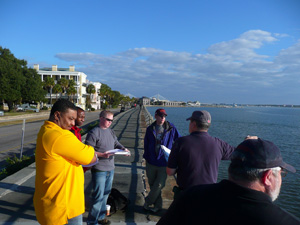 |
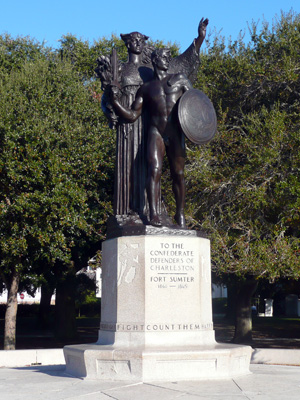 |
| The location of Battery Ramsey | Confederate monument at the tip of Charleston |
Next we drove to the Charleston Museum, where there is a full-size replica of the H.L. Hunley, the Confederate submarine that sunk a Union blockade ship, the Housatonic, in 1864. (In my previous trip to Charleston I visited the real Hunley, but unless they have improved the situation in the last five years, there is really very little to see other than a dark shape in a dimly lit tank of water.) There was a consensus that the objective of the sub was to wear down the blockading fleet, expecting that this might loosen the blockade and allow more runners to get through. Of course, while sinking the Union ship, the Hunley also perished with all aboard. I reported on my conference in San Francisco the previous week, where I learned that researchers were able to analyze some brain tissue of the crew and determined that they died of asphyxiation, not drowning, although the actual cause for this has not been determined. Our naval officer, who had spent some time in the submarine service, was not impressed with this vessel. :-) Nearby there was a public park with a fragment of an American Revolutionary War fortification called the Horn Work, which was of an interesting composition including a lot of seashells. We took this opportunity to discuss general principles of siege warfare.
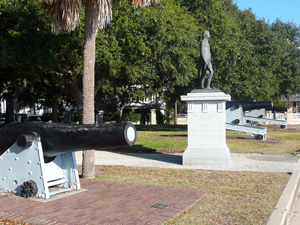 |
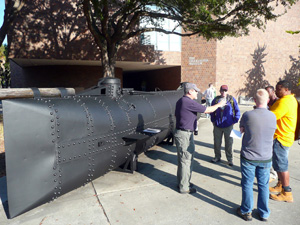 |
| Guns and statues at White Point Gardens | Replica of the H. L. Hunley |
The next logical stop would have been Morris Island, where the most significant land actions of 1863 occurred, but those sections of land have now been submerged and there are no access roads to the island anyway. (We were told that the Civil War Preservation Trust has actually preserved some of this land so that it will not be exploited in the future.) So we did the next best thing, which was to visit Folly Island, just to the southwest. We drove to the end of the road and then hiked about half a mile to the beach at Lighthouse Inlet. This is named for the lighthouse at the southern end of Morris Island, which is now stranded out in the ocean. It was across this outlet from the Folly River that Union troops made an amphibious assault onto Morris Island on July 10, 1863. We discussed the planning process of Brig. Gen. Quincy A. Gillmore, the Union Army commander, and determined that he selected an appropriate course of action. He received some criticism because he had the Confederates on the run and if he had acted swiftly, he might have been able to overrun Battery Wagner that day. Instead, his troops were ordered to stop and then on July 11 they conducted a hasty attack. Our naval student described that action as "They got their asses handed to them."
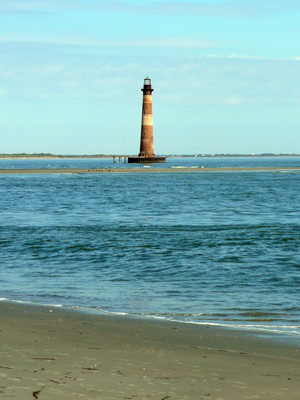 |
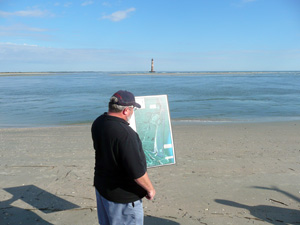 |
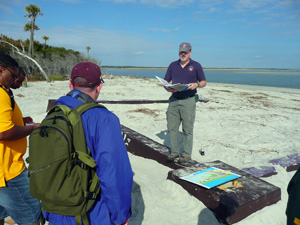 |
| Morris Light, tilting slightly | Examining the remains of Morris Island by map | Battery Wagner sand table exercise |
The followup attack on July 18 had better planning and we analyzed it in detail. Gary set up a very large sand table, showing on a large scale how the approach to the fort was constrained to a very narrow front by the ocean on one side and a swamp on the other. Luckily, an abandoned foundation on the beach was available to serve as the fort. We made use of students to represent different units and to see how they advanced and interacted. I got to simulate the 51st North Carolina inside the fort, which did not take much effort on my part, except that I was hit by friendly fire from the 31st North Carolina, which had been hiding in the bombproof. We could see very graphically how the Union units were deployed in waves, piecemeal, and the effect of retreating men on new units trying to advance. We judged that Brig. Gen. George C. Strong, the leading brigade commander, should have been advancing with his second wave; the first wave, led by the famous 54th Massachusetts, was essentially doomed to failure, but Strong could have ensured that his second wave came in at the right time. (Instead, he advanced with the first wave and was killed.) One of the lessons that should have been learned by the Union commanders is that it is almost impossible to reduce a fortification with artillery alone, something they had been counting on. Du Pont's experience at Fort McAllister should have reinforced that. Our infantry officer student remarked that the Army did not really learn this lesson until the Somme!
We concluded our visit to Folly Island with a discussion of the siege operation against Battery Wagner, and asked the question about whether the entire operation was worth it. Most thought that it was and our naval student pointed out that when Morris Island fell, all blockade runners were shut out of Charleston for the rest of the war. We also discussed the relevance of siege operations to the current Army and the students were quick to come up with examples, such as Kandahar.
We drove back to Charleston to visit the Fort Sumter National Monument. We stood on the balcony of the visitor center to discuss the bombardment of Fort Sumter from Morris Island. One of the NPS ranger ladies was very excited that we were carrying large colorful maps on our trip, but after that we were generally ignored by the many tourists. On the boat ride to Sumter we had a great view of Fort Johnson, Fort Moultrie, and Castle Pinckney. The boat simply crawled along at under 6 kn, which we were told was twice as fast as the monitors that attempted to enter the harbor to attack the fort. I was surprised to see that there are numerous dolphins in Charleston Harbor, and they were very interested in following the boat around. It was low tide when we reached the fort and I noticed that it is now connected by land bridge to the west—dredging operations in the harbor over the years have created a new minor island that is in between Fort Johnson and Cummings Point.
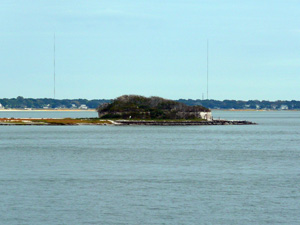 |
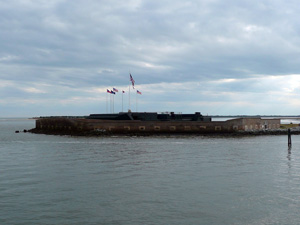 |
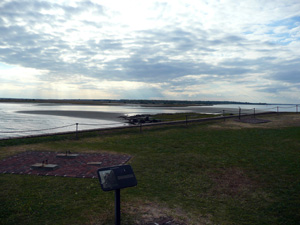 |
| Castle Pinckney | Fort Sumter | The land bridge from Fort Sumter |
Although stepping onto Sumter exercises obvious psychological/emotional ties, it is actually a bit physically disappointing. The 50-foot-high walls that existed before all of the bombardments are now only one story high and the center of the fort has been filled with a giant, monolithic black concrete structure. The fort was actually used by the Army until 1948, so this was a remnant of a later fortification. We discussed the night attack on September 8 that was conducted by the Navy. Gillmore had separately planned to attack on the same day, but held off so that Adm. Dahlgren's men would not be interfered with. The attack was a fiasco and interrupted a series of well coordinated joint actions between the Army and the Navy during the campaign. We also discussed the bombardment of Charleston itself from Morris Island, an act that some historians have described as terrorism (in my opinion this judgment is not warranted because there were legitimate military targets in the city and the Army announced the bombardment in advance, allowing civilians to evacuate). The Confederates were so outraged that they brought five captured Union generals from prison and stationed them around at strategic points in town. We had some free time before the boat departed to visit the decent museum and wander around the gun emplacements.
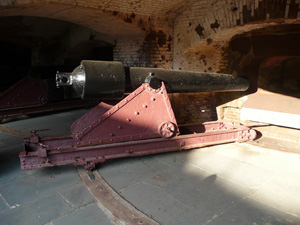 |
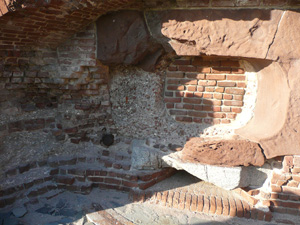 |
| Parrott rifle in casemate | Union bolt embedded in the masonry |
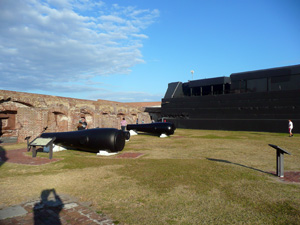 |
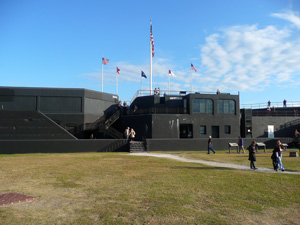 |
| Cannon tube display | The unsightly Endicott fortification inside Fort Sumter |
Sunday
The final segment of the staff ride was the integration phase, which was conducted in the open courtyard of the Marriott Hotel on Sunday morning. The weather continued to be really beautiful. Curt passed out the grades to each student prior to this discussion because it was not part of their evaluations, apparently. The discussion included summary comments about the terrain, joint command issues, and leadership. One of the students remarked that terrain is 75% of the battle. The Confederates seemed to have a good eye for terrain and everyone agreed that the most effective leader in understanding and exploiting terrain—the hero of the battles—was P.G.T Beauregard. Most agreed that the two most interesting terrain features were the constrained approach to Fort Lamar and the unexpected proximity of Sumter to Sullivan and Morris Islands. "Sumter was just a nine-iron shot from Morris Island." Given this geography, the students agreed that Fort Sumter was definitely worth taking.
The discussion about joint command was pretty straightforward, given the obvious lack of unity of command throughout the campaign. Students remarked that even though the modern military now always sets up a clear joint commander for an operation, personalities of leaders sometimes get in the way of cooperation, just as happened here in the 1860s. Effective staff officers working for these commanders can sometimes smooth over the personal disagreements that would normally get in the way. The discussion about leadership was not intended to select the best or worst generals (which would normally be a favorite topic in a civilian Civil War tour). A student judged that there was a lack of mission-focused orders, and we had a discussion of the orders from Du Pont, which called for the reduction of Fort Sumter, but was vague about the operational details and gave his subordinates no additional guidance on what to do if they were successful. A question came up about Roswell Ripley, the general who was actually in command of the Charleston district, and no one seemed to know what he did because Beauregard, the three-state department commander, seemed to be in full control and Ripley had no effect on the field operations.
I had a great time joining the Army on the staff ride. I was certainly impressed with the students and the faculty, particularly the amount of preparation that both did beforehand. The schedule ran like clockwork, the visual aids were excellent, and the discussions on site were fast-paced, focused, and insightful. One of my objectives was to determine the difference between this staff ride and the civilianized versions I have experienced. The two primary differences are that the students here are much more prepared and are required to read and present more than their civilian counterparts, and that the students obviously have more skin in the game than civilians do. Curt asked them to fill out an evaluation form in which they were supposed to judge the relevancy of this to their careers. I am sorry I did not get to see their answers, but I would gamble that most would say it was a positive experience. It certainly was for me. Thanks to Curt, Gary, Bruce, Colin, Craig, and Marty for having me tag along.
| The website view of Middleton Place |
I had the rest of the day to occupy before I traveled to Mount Pleasant for dinner with some local relatives (cousins Gould, Elise, and Linda), so I decided to take advantage of my rental car and drive to one of the famous plantations outside Charleston. I chose Middleton Place, which is on the National Register of Historic Places, about a 30 minute drive northwest of the city. There were some interesting aspects that I enjoyed, but in general this place is not meant for people with Y chromosomes. It was built in the mid-18th century and named after Henry Middleton, who served in the First Continental Congress. His son Arthur was one of the signers of the Declaration of Independence. The next generation was another Henry, who was a governor of South Carolina, and then Williams, who was one of the signers of the South Carolina Ordinance of Secession. War did not go well for Williams: he lost all of his fortune buying Confederate war bonds and New York troops burned all the buildings on the plantation in 1865. Then, a big earthquake in 1886 completely demolished the brick ruins that remained. So the main house is a pile of bricks and only one of the "flanking houses" was rebuilt. That house is now the small museum. The big selling point is all of the fabulous gardens, but it seems that South Carolina must be having a drought because all the grass was brown. I have included a photograph from their website, which looks dramatically better than the property did today.
I took a carriage ride, pulled by two large Belgian workhorses, that roamed around in the woods while the driver gave us a history of the property. We passed through an old rice field, which contained two alligators, but I wasn't able to see them when the driver pointed them out. I also took the house tour, which was rather odd because the house was so dimly lit that the tour guide had to show us most things by flashlight. There were a couple of interesting tidbits in the house. There was a pass signed by A. Lincoln that was obtained by one of the women of the family to return to Tennessee from Washington. And I found a photograph of David Farragut, which unearthed the information that one of Williams's brothers was in the Union Navy. I wandered around the back of the property and found a man doing woodwork using period tools, building primarily tiny barrels to be sold in the gift shop. A lady gave me a demonstration of grinding corn and rice (the plantation was a significant rice producer). And I was able to interact with some of barnyard animals, including numerous chickens running around loose, sheep, a cow, some more horses, and two water buffaloes. During the 19th century, some water buffaloes were imported from Asia to assist in the rice farming activities; they have hooves that are more suitable for standing around in the water than horses do. So, some men may have enjoyed themselves, assuming they had the $45 admission and tour add-ons to spend, but I absorbed the lesson and decided to forsake some of the neighboring plantations that were also available for visiting.
This was my last Civil War trip of 2010! Early in 2011 I will create a new page that will include some of my proposed travel next year. Happy Thanksgiving, Merry Christmas, and Happy New Year!
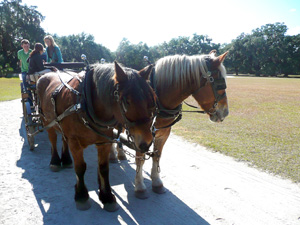 |
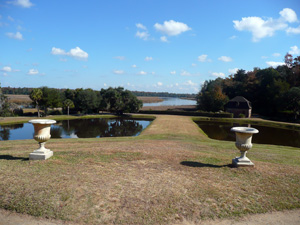 |
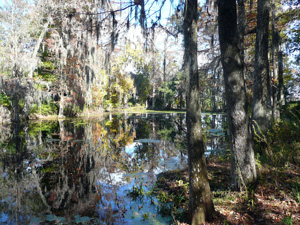 |
| Max and Jake pulled our wagon | The current state of the grass overlooking the Ashley River | Garden scene |
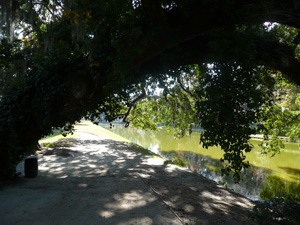 |
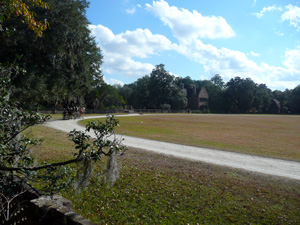 |
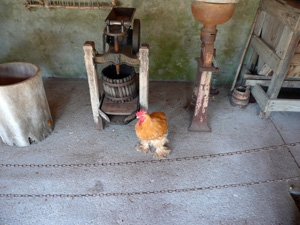 |
| Reflecting pool | Approach to the museum house | A friendly chicken visiting a display area |
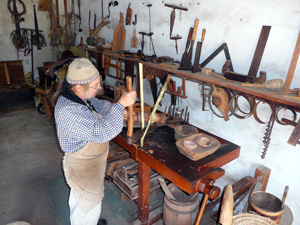 |
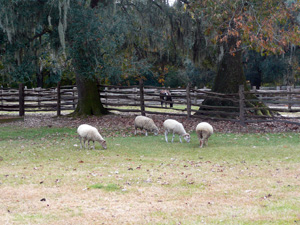 |
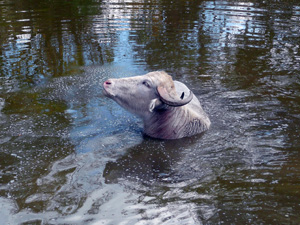 |
| A mini-cooper | Sheep | One of two water buffaloes |
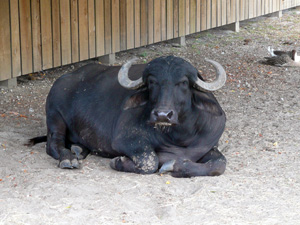 |
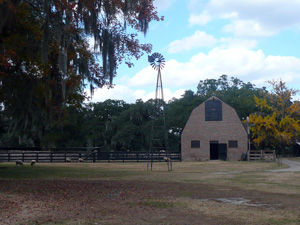 |
| The other | Farm scene |
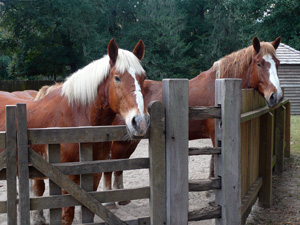 |
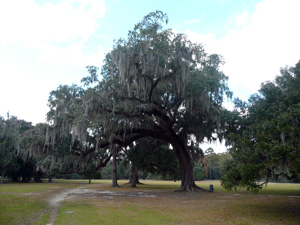 |
| Two of the workhorses (who are much larger than they look here!) on break | Some of the ubiquitous Spanish moss (which the horses love to eat) |